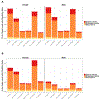Data needed to respond appropriately to anemia when it is a public health problem
- PMID: 31267542
- PMCID: PMC8291089
- DOI: 10.1111/nyas.14175
Data needed to respond appropriately to anemia when it is a public health problem
Abstract
Although the proportion of anemia amenable to change varies by population, the World Health Organization (WHO) criteria used to describe the public health severity of anemia are based on population prevalences. We describe the importance of measuring iron and other etiologic indicators to better understand what proportion of anemia could be responsive to interventions. We discuss the necessity of measuring inflammation to interpret iron biomarkers and documenting anemia of inflammation. Finally, we suggest assessing nonmodifiable genetic blood disorders associated with anemia. Using aggregated results from the Global Burden of Disease 2016, we compare population prevalence of anemia with years lived with disability (YLD) estimates, and the relative contributions of mild, moderate, and severe anemia to YLD. Anemia prevalences correlated with YLD and the relative proportion of moderate or severe anemia increased with anemia prevalence. However, individual-level survey data revealed irregular patterns between anemia prevalence, the prevalence of moderate or severe anemia, and the prevalence of iron deficiency anemia (IDA). We conclude that although the WHO population prevalence criteria used to describe the public health severity of anemia are important for policymaking, etiologic-specific metrics that take into account IDA and other causes will be necessary for effective anemia control policies.
Keywords: anemia; disability-adjusted life years; iron deficiency anemia; public health significance.
© 2019 New York Academy of Sciences.
Conflict of interest statement
Competing interests
The authors declare no competing interests.
Figures


References
-
- WHO. 2001. Iron Deficiency Anaemia. Assessment, Prevention and Control. A Guide for Programme Managers Geneva: World Health Organization.
-
- WHO. 2011. Hemoglobin Concentrations for the Diagnosis of Anemia and Assessment of Severity. Geneva:World Health Organization.
-
- WHO. 2017. Nutritional Anaemias: Tools for Effective Prevention and Control. Geneva:World Health Organization.
-
- Stoltzfus RJ, Mullany LC & Black RE. 2004. Iron Deficiency Anemia. Geneva:World Health Organization.
Publication types
MeSH terms
Substances
Grants and funding
- CC999999/ImCDC/Intramural CDC HHS/United States
- Evidence and Programme Guidance Unit/International
- Evidence and Programme Guidance Unit, Department of Nutrition for Health and Development of the World Health Organization (WHO), Geneva, Switzerland/International
- Department of Nutrition for Health and Development of the World Health Organization (WHO)/International
LinkOut - more resources
Full Text Sources
Medical

